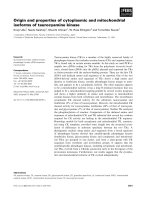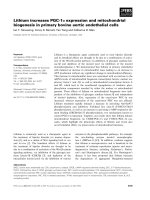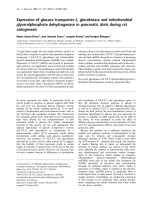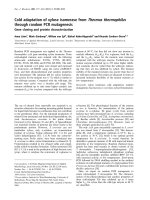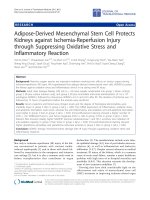PURIFIED HERBA LEONURI AND LEONURINE PROTECT MIDDLE CEREBRAL ARTERY OCCLUDED-RATS FROM BRAIN INJURY THROUGH ANTIOXIDATIVE MECHANISM AND MITOCHONDRIAL PROTECTION
Bạn đang xem bản rút gọn của tài liệu. Xem và tải ngay bản đầy đủ của tài liệu tại đây (887.05 KB, 32 trang )
PURIFIED HERBA LEONURI AND LEONURINE
PROTECT MIDDLE CEREBRAL ARTERY OCCLUDED-
RATS FROM BRAIN INJURY THROUGH
ANTIOXIDATIVE MECHANISM AND MITOCHONDRIAL
PROTECTION
LOH KOK POH
B.Sc. (Hons.), NUS
A THESIS SUBMITTED
FOR THE DEGREE OF DOCTOR OF PHILOSOPHY
DEPARTMENT OF PHARMACOLOGY
NATIONAL UNIVERSITY OF SINGAPORE
2009
Once we accept our limits,
we go beyond them.
Albert Einstein (1879 – 1955)
Acknowledgement
Department of Pharmacology,
YLL School of Medicine
i
Acknowledgement
I would like to acknowledge my debt to those who have helped along the way and
influenced the formation of this thesis.
In particular, I am deeply grateful to my supervisor, Professor Zhu Yi-Zhun, M.B.B.S.,
Ph.D., Associate Professor of Pharmacology, Yong Loo Lin School of Medicine,
National University of Singapore, who gave me an invaluable opportunity to work with
him, introduced me to the field of natural products and cerebral ischemia. His extensive
discussions during my course of research and untiring help during my difficult moments
have been very helpful. His understanding, encouraging and personal guidance have
provided a good basis for the present thesis.
I would like to express my deep and sincere gratitude to my supervisor, Associate
Professor Tan Kwong Huat, Benny, M.B.B.S., Ph.D., Department of Pharmacology,
Yong Loo Lin School of Medicine, National University of Singapore, for his wide
knowledge and his detailed and constructive comments, which have been of great value
for me.
I express my warm and sincere thanks to Dr. Wang Hong for her valuable advice and
friendly help. Her extremely valuable experiences support and insights have been of great
value in this study. I warmly thank Dr. Wang Zhong Jing, for introducing me the field
Acknowledgement
Department of Pharmacology,
YLL School of Medicine
ii
of mitochondria and for sharing me his experiences about the problem issues involved.
His ideals and concepts have had a remarkable influence on my research path.
I wish to extend my appreciation to Dr. Huang Shan Hong for her expert GC-MS
analysis of the samples and drug used in this study, Tan Tong San, Ms. Vincent
Annette Shoba, and Ms. Lim Hwee Ying from Professor Sit Kim Ping’s lab, for their
excellent guidance on mitochondrial studies.
My sincere thanks are due to my thesis advisory committe, Associate Professor
Charanjit Kaur, Associate Professor Ng Yee Kong and Associate Professor Tan
Kwong Huat, Benny, for their detailed review, constructive criticism and excellent
advice during the preparation of this thesis.
I wish also to extend my appreciation to Animal Holding Unit (AHU), National
University of Singapore, which provides excellent research facilities for animal study. I
am thankful to AHU laboratory staff Low Wai Mun James, Loo Eee Yong Jeremy, and
the rest for their assistance, friendship and extremely positive attitude towards me.
I am grateful for the scholarship from Yong Loo Lin School of Medicine, National
University of Singapore, without which writing this thesis might not be possible. The
financial support of the Herbatis is gratefully acknowledged.
Acknowledgement
Department of Pharmacology,
YLL School of Medicine
iii
Without friends, life as a graduate student would not be the same. Ms Ler Lian Dee, Ms
Irene Lee Cheng Jie, Mr Ling Moh Lung, special friends to me, and the many
discussions we had, be they research-related or not, were often the occasion for new
discoveries and always truly agreeable moments. Ms Ning Li, Ms Chuah Shin Chet, Ms
Wong Wan Hui, Ms Low Lishan, their friendships are valuable to me and I want to
thank them for their pragmatic approach to problem solving and their honesty. It is,
however, not possible to list all of them here. Their support in this research, to be directly,
or indirectly, is greatly appreciated.
I owe my loving thanks to my family. Without their encouragement and understanding
for the past 27 years, it would have been impossible for me to be whom I am today. My
special gratitude is due to my brother, for his never-ending loving support. I thank my
husband, Mr. Yeong Sai Hooi. His love to me is always a powerful source of inspiration
and energy.
Table of Contents
Department of Pharmacology,
YLL School of Medicine
iv
Table of Contents
Acknowledgement……………………………………………………………… i
Table of Contents…………………………………………………………………. iv
List of Abbreviations…………………………………………………………… x
List of Tables……………………………………………………………………… xiii
List of Figures…………………………………………………………………… xiv
Summary………………………………………………………………………… xvii
List of Publications……………………………………………………………… xx
Chapter 1 General Overview…………………………………………………. 1
1.1 Overview……………………………………………………………… 2
1.2 Objectives………………………………………………………………… 7
1.3 Structure of thesis………………………………………………………… 9
Chapter 2 Introduction: Ischemic Stroke, CNS mitochondria and
Therapeutic Potential of Traditional Chinese Medicine………
11
2.1 Pathophysiology of stroke…………………………………………………. 12
2.1.1 Ischemic stroke………………………………………………… 13
2.1.2 Cell death in stroke………………………………………………. 16
2.1.2.1 Ischemic cascade………………………………………. 16
2.1.2.2 Apoptosis………………………………………………. 19
2.1.3 Oxidative stress of stroke……………………………………… 25
2.1.4 Rodent ischemic stroke models………………………………… 30
Table of Contents
Department of Pharmacology,
YLL School of Medicine
v
2.2 CNS mitochondria…………………………………………………………. 35
2.2.1 Protective physiological roles of CNS mitochondria……………. 35
2.2.2 Mitochondria and apoptosis…………………………………… 37
2.2.3 Mitochondria and ROS………………………………………… 39
2.2.3.1 Mitochondria source of ROS……………………… 39
2.2.3.2 Mitochondria target of ROS………………………… 42
2.2.4 Mitochondrial involvement in stroke……………………………. 44
2.3 Traditional Chinese medicines (TCM)……………………………………. 48
2.3.1 Gingko biloba 49
2.3.2 Braintone………………………………………………………… 52
2.3.3 Herba leonuri (HL) and purified Herba leonuri (pHL)…………. 54
2.3.4 Leonurine……………………………………………………… 57
Chapter 3 Materials and Methods……………………………………………. 59
3.1 Drug preparations………………………………………………………… 60
3.1.1 Purified Herba leonuri (pHL)…………………………………… 60
3.1.2 Leonurine……………………………………………………… 60
3.2 Animals……………………………………………………………………. 61
3.3 Middle cerebral artery occlusion (MCAO)……………………………… 61
3.4 Experimental protocols……………………………………………………. 62
3.4.1 Experimental protocol I…………………………………………. 62
3.4.1.1 Objectives……………………………………………… 62
3.4.1.2 Experimental design…………………………………… 62
Table of Contents
Department of Pharmacology,
YLL School of Medicine
vi
3.4.2 Experimental protocol II………………………………………… 64
3.4.2.1 Objectives……………………………………………… 64
3.4.2.2 In vitro mitochondrial studies…………………………. 64
3.4.2.3 In vivo mitochondrial studies………………………… 65
3.4.3 Experimental protocol III……………………………………… 67
3.4.3.1 Objectives……………………………………………… 67
3.4.3.2 In vivo studies – animal treatment and MCAO……… 67
3.4.3.3 In vitro mitochondrial studies…………………………. 68
3.4.3.4 In vivo mitochondrial studies………………………… 69
3.5 Experimental techniques………………………………………………… 71
3.5.1 Infarct volume measurement…………………………………… 71
3.5.2 Evaluation of neurological deficit……………………………… 71
3.5.3 Total antioxidant assay………………………………………… 72
3.5.4 DNA oxidative damage analysis using GC/MS………………… 73
3.5.5 TUNEL (TdT-mediated dUTP Nick-End Labeling) assay……… 75
3.5.6 Immunohistochemical staining………………………………… 77
3.5.7 Superoxide dismutase (SOD) activity assay…………………… 79
3.5.8 Glutathione peroxidase (GPx) activity assay……………………. 80
3.5.9 Lipid peroxidation product measurement……………………… 81
3.5.10 Preparation of intact rat brain mitochondria…………………… 81
3.5.11 Measurement of mitochondrial membrane potential – JC-1 assay 82
3.5.12 Measurement of ROS in isolated mitochondria…………………. 83
3.5.13 ATP biosynthesis in isolated mitochondria……………………… 84
Table of Contents
Department of Pharmacology,
YLL School of Medicine
vii
3.5.14 Mitochondrial respiration measurement…………………………. 85
3.5.15 Glutathione level in isolated mitochondria……………………… 87
3.6 Statistical analysis…………………………………………………………. 88
Chapter 4 Results……………………………………………………………… 89
4.1 Results of experiment I: Cerebral Protection of Purified Herba Leonuri
Extract on Middle Cerebral Artery Occluded-Rats………………………
90
4.1.1 Pharmacological and functional outcome studies……………… 90
4.1.1.1 pHL reduced infarct volume resulted from MCAO…… 90
4.1.1.2 pHL ameliorated the neurological outcome of MCAO-
induced rats…………………………………………….
92
4.1.2 Biochemical, cellular and molecular approaches……………… 95
4.1.2.1 MCAO decreased plasma antioxidant level and
protection of pHL on the plasma antioxidant level…….
95
4.1.2.2 Increased oxidative stress by MCAO and prevention by
pHL…………………………………………………….
96
4.1.2.3 Enhanced TUNEL nuclear green by MCAO and
prevention by pHL……………………………………
97
4.1.2.4 Apoptosis involvement of stroke and protection of pHL 99
4.2 Results of experiment II: Modulation of Mitochondrial ROS Generation
and Function by Purified Herba Leonuri Extract…………………………
103
4.2.1 Quality of isolated cortical mitochondria preparation…………… 103
4.2.2 Mitochondrial ROS production and prevention by pHL in vitro 105
Table of Contents
Department of Pharmacology,
YLL School of Medicine
viii
4.2.3 Effect of pHL on ATP biosynthesis in isolated mitochondria… 108
4.2.4 Effect of pHL on mitochondrial respiration and RCR value……. 110
4.2.5 Effect of pHL on mitochondrial GSH in vivo…………………… 117
4.3 Results of experiment III: Leonurine (4-guanidino-n-butyl Syringate)
Protects the Middle Cerebral Artery Occluded-Rats through Antioxidant
effect and Regulation of Mitochondrial Function…………………………
119
4.3.1 Effect of Leonurine on functional outcome of MCAO-induced
rats………………………………………………………………
119
4.3.2 Effect of Leonurine on oxidative stress in MCAO-induced rats… 122
4.3.3 Effect of Leonurine on ROS production in isolated mitochondria 123
4.3.4 Effect of Leonurine on ATP biosynthesis in isolated
mitochondria……………………………………………………
126
4.3.5 Effect of Leonurine on mitochondrial respiration……………… 129
4.3.6 Effect of Leonurine on mitochondrial GSH in vivo…………… 134
Chapter 5 Discussion………………………………………………………… 135
5.1 Discussion on experiment I……………………………………………… 137
5.2 Discussion on experiment II………………………………………………. 146
5.3 Discussion on experiment III……………………………………………… 159
5.4 General discussion…………………………………………………………. 166
Chapter 6 Conclusion and Future Perspectives…………………………… 174
6.1 Conclusion…………………………………………………………………. 175
6.2 Limitation of study………………………………………………………… 179
Table of Contents
Department of Pharmacology,
YLL School of Medicine
ix
6.3 Future perspectives………………………………………………………… 180
References………………………………………………………………………… 184
List of Abbreviations
Department of Pharmacology,
YLL School of Medicine
x
List of Abbreviations
ADP adenosine diphosphate
AHA American Heart Association
ANT adenine nucleotide translocator
Apaf-1 apoptotic protease activating factor 1
AIF apoptosis inducing factor
AMP adenosine monophosphate
ATP adenosine triphosphate
BBB blood brain barrier
BNIP3 Bcl-2/adenovirus E1B 19kDa-interacting protein
BID Bcl-2 interacting domain
BSA bovine serum albumin
CAD caspase-activated deoxyribonuclease
CBF cerebral blood flow
CBV cerebral blood volume
CMRO
2
cerebral metabolic rate of oxygen
CoQ coenzyme Q
DD death domain
DED death effector domain
DISC death-inducing signaling complex
DNA deoxyribonucleic acid
DTNB 5, 5’-dithiobis-2-nitrobenzoic acid
List of Abbreviations
Department of Pharmacology,
YLL School of Medicine
xi
ESR electron spin resonance
ETC electron transport chain
FADD Fas-associated death domain protein
FasL Fas ligand
FDA Food and Drug Administration
FMN flavin mononucleotide
GSH glutathione (reduced)
GSSG glutathione (oxidized)
GPx glutathione peroxidase
HL Herba leonuri
IAP inhibitor of apoptosis
IHC immunohistochemical staining
LC-ESI-MS liquid chromatograph electrospray ionization mass spectrometry
MCAO middle cerebral artery occlusion
MDA malondialdehyde
MI myocardial infarction
mitoK
ATP
mitochondrial ATP-sensitive K
+
channel
MPTP mitochondrial permeability transition pore
NFkB nuclear factor-kappa B
NMDA N-methyl-D-aspartate
NO nitric oxide
NOS nitric oxide synthase
PARP poly (ADP-ribose) polymerase
List of Abbreviations
Department of Pharmacology,
YLL School of Medicine
xii
PCD programmed cell death
PET Positron emission tomography
pHL purified Herba leonuri
ROS reactive oxygen species
rt-PA recombinant tissue type plasminogen activator
SOD superoxide dismutase
tBID truncated form of BID
TBA thiobarbituric acid
TCA tricarboxylic acid cycle
TCM Traditional Chinese medicine
TNB 5-thio-2-nitrobenzoic acid
TNFR tumor necrosis factor receptor
TTC 2,3,5-triphenyltetrazolium chloride
UCP uncoupling protein
VO vessel occlusion
WHO World Health Organization
List of Tables
Department of Pharmacology,
YLL School of Medicine
xiii
List of Tables
Table 3-1 Groups for studies of effect of pHL on isolated mitochondria
Table 3-2 Grouping for studies of effect of Leonurine on isolated mitochondria
Table 4-1 Neurological deficit grading system.
Table 4-2 Levels of SOD, GPx and MDA in each treatment group.
List of Figures
Department of Pharmacology,
YLL School of Medicine
xiv
List of Figures
Figure 2-1 a) Ischemic stroke; and b) hemorrhagic stroke (arrow)
Figure 2-2 A diagram illustrates the ischemic cascade
Figure 2-3 A schematic diagram of apoptosis
Figure 2-4 A flow chart showing the involvement of ROS in multiple ischemic
cascades
Figure 2-5 The spatial pattern of cerebral blood flow (CBF) in MCAO
Figure 2-6 A schematic model of ETC and ROS generation in the mitochondria
Figure 2-7 Fenton reaction
Figure 2-8 Gene expression level of a) AT2 receptor, b) Fas, c) Bax, and d) ratio of
Bcl-xL/Bcl-xS was measured from left cortex after 7 days of MCAO
Figure 2-9 Gene expression level of a) AT2 receptor, b) Fas, c) Bax, and d) ratio of
Bcl-xL/Bcl-xS
Figure 2-10 The 5 known compounds from pHL
Figure 3-1 A Flow chart represents the experimental outline in the pilot study of pHL.
Figure 3-2 Flow charts represent the general outlines of experimental protocol II.
Figure 3-3 A Flow chart represents the experimental outline in the pilot study of
Leonurine.
Figure 3-4 Flow charts represent the general outlines of mitochondrial studies for
Leonurine.
List of Figures
Department of Pharmacology,
YLL School of Medicine
xv
Figure 4-1 Infarct volume measured from each treatment group. a) Images of cerebral
sections among the treatment groups. b) Infarct volume was analyzed by
image analyzer system (Scion image for windows).
Figure 4-2 Neurological deficit score among treatment groups (n>20).
Figure 4-3 Plasma total antioxidant concentration of each treatment group under the
influence the pHL.
Figure 4-4 The DNA oxidative damage level in each treatment group.
Figure 4-5 Apoptotic staining in cerebral cortex after 7 days of MCAO (20x
magnification) for each treatment group.
Figure 4-6 Light photomicrographs (10x magnification) of cryostat section of the rat
left cerebral cortex.
Figure 4-7 Immunohistochemical staining of pro-apoptotic protein (b: BAX and c:
FAS) and anti-apoptotic protein (d: BCL-2 and e: BCL-XL) in cerebral
cortex after 7 days of MCAO (40x magnification), with a: negative control.
Figure 4-8 Quantitative recordings of the membrane potential from isolated cortical
mitochondria.
Figure 4-9 Effects of pHL on cortical mitochondrial ROS generation determined by
oxidation of DCFDA.
Figure 4-10 Effects of pHL on ATP biosynthesis of succinate treated cortical
mitochondria in the absence (a) or presence (b) of 1mM H
2
O
2
.
Figure 4-11 Effects of pHL on metabolic rates of isolated mitochondria (n=4).
Figure 4-12 Oxygen consumption of left cortical mitochondria (a, b, c) and right
cortical mitochondria (e, d, f)
List of Figures
Department of Pharmacology,
YLL School of Medicine
xvi
Figure 4-13 GSH concentration from each treatment group in vivo. GSH concentration
was enhanced 3 hours after MCAO.
Figure 4-14 a) Infarct area of each treatment group was observed by TTC staining. b)
Infarct volume was then analyzed by image analyzer system (Scion image
for windows).
Figure 4-15 Effect of Leonurine on cortical mitochondrial ROS production determined
by changes in DCF oxidation.
Figure 4-16 Effect of Leonurine on ATP biosynthesis of succinate treated cortical
mitochondria in the absence (a) or presence (b) of 1mM H
2
O
2
.
Figure 4-17 Oxygen consumption (a) and respiratory control ratio (RCR) (b) of
isolated mitochondria.
Figure 4-18 Oxygen consumption of left cortical mitochondria (a) and right cortical
mitochondria (c). Respiratory control ratio (RCR) of left cortical
mitochondria (b) and right cortical mitochondria (d).
Figure 4-19 GSH concentration from each treatment group in vivo.
Summary
Department of Pharmacology,
YLL School of Medicine
xvii
Summary
Ischemic stroke refers to the condition caused by the occlusion of blood vessels, causing
the injury of the territory of the supplied brain region. With ample evidences showed that
free radicals play a role in ischemic cascade, studies focusing on traditional Chinese
medicines (TCMs) have shown its promising effects in neuroprotection due to their
antioxidant properties. In this research, therapeutic potentials of purified Herba leonuri
(pHL) and one of its active ingredients Leonurine on ischemic stroke were investigated.
Rodent model of permanent focal ischemia by left middle cerebral artery occlusion
(MCAO) in Wistar rats was employed in this research. Left MCAO model resulted in
infarct spanning left cortical and striatal tissues with neurological impairment, oxidative
stress, apoptosis and mitochondrial dysfunction. In experiment I, MCAO-induced rats
pretreated with pHL for 14 days prior to the induction of stroke, followed by another 7
days of post-operation treatment was demonstrated to have reduction in infarct volume
from 20.75 ± 0.03% to 15.19 ± 0.02% (p<0.05). The pHL-administered rats had also
improvement of neurological outcome. Comparing to stroke group, total plasma
antioxidant concentration was increased 1.34-fold (p<0.05) while level of DNA oxidative
damage was reduced to 0.67-fold (p<0.05). Therefore, therapeutic effect of pHL is
believed to act through antioxidant effects. In addition, experimental results also showed
that pHL might interfere with apoptosis signaling as apoptosis level was reduced as
shown by TUNEL assay.
Summary
Department of Pharmacology,
YLL School of Medicine
xviii
In experiment II, lowered mitochondrial ROS generation level was observed in the
isolated mitochondrial treated with pHL, in a dose-dependent manner, suggesting that
pHL prevents the contribution of mitochondria to oxidative stress. This is accompanied
with the lowered ATP biosynthesis which could be the effect of metabolic arrest, leading
to the cytoprotective barrier to the mitochondria. A slight increase of state 4 respiration
by the treatment of pHL suggests that pHL might also have a mild uncoupling effect
which has been shown to be a cytoprotective strategy. Similarly, as mitochondria were
pre-treated with H
2
O
2
as ROS inducer, pHL suppressed both mitochondrial ROS
generation and ATP biosynthesis, indicating that protective effects of pHL could be
executed in both physiological and pathological conditions. In vivo mitochondrial studies
showed that mitochondrial dysfunction by MCAO could be rescued by the treatment of
pHL. Mitochondrial respiration, particularly state 3 respiration was greatly enhanced
from 47.75±7.90% to 93.02±8.20% (p<0.05). In addition, balanced GSH pool was
observed under the treatment of pHL, in both healthy and MCAO-induced rats.
In experiment III, the study was extended to the research to the investigation of the
therapeutic potential of Leonurine, a key and unique compound found in both Herba
leonuri (HL) and pHL, on ischemic stroke model. Animal was pretreated with Leonurine
orally for 7 days before the middle cerebral artery occlusion (MCAO) was done. This
study demonstrated that one day after surgery, Leonurine treatment at 60mg/kg/day could
significantly reduce infarct volume from 22.45%±2.88% to 13.5%±1.74% (p<0.05),
improve neurological deficit in stroke group. As compared to stroke group, increased
activities of antioxidant enzymes SOD (1.66-fold, p<0.05) and GPx (1.83-fold, p<0.05)
Summary
Department of Pharmacology,
YLL School of Medicine
xix
and decreased MDA level (0.53-fold, p<0.05) was also observed in stroke group treated
with Leonurine, indicating the antioxidative mechanisms of Leonurine. In vitro studies
showed that Leonurine also inhibited mitochondrial ROS production and ATP
biosynthesis, dose-dependently, indicating the similar protective effect was observed
between pHL and Leonurine. Mitochondrial function was also rescued by Leonurine
treatment in rats subjected to MCAO. Mitochondrial state 3 respiration was enhanced
from 40.74±5.11% to 102.82±1.28% (p<0.05) in stroke groups.
To summarize, both pHL and Leonurine carry a potential effects on stroke therapy, at
least via antioxidant effects and modulation of mitochondrial function.
List of Publications
Department of Pharmacology,
YLL School of Medicine
xx
List of Publications
1. K.P. Loh, L.S. Low, W.H. Wong, S. Zhou, S.H. Huang, R. De Silva, W. Duan, W.H.
Chou, Y.Z. Zhu. A comparison study of cerebral protection using Ginkgo biloba
extract and Losartan on stroked rats. Neuroscience Letters, 398, 28-33, 2006.
2. K.P. Loh, S.H. Huang, R.D. Silva, B.K.H. Tan and Y.Z. Zhu. Oxidative Stress:
Apoptosis in Neuronal Injury. Current Alzheimer Research, 3, 327-337, 2006.
3. K.P. Loh, S.H. Huang, B.K.H. Tan, V. Chou, Y.Z. Zhu. Cerebral Protection of
Purified Herba Leonuri Extract on Middle Cerebral Artery Occluded Rats. Journal of
Ethnopharmacology. 125, 337-343, 2009. Epub 2009 Jun 2.
4. K.P. Loh, W.H. Wong, L.S. Low, H. Wang, B.K.H. Tan, V. Chou, Y.Z. Zhu.
Mechanisms of cerebral protection of Chinese herbal extract-Braintone on middle
cerebral occluded rats. Journal of Chinese Pharmaceutical Sciences, 18(2), 106- 113,
2009
5. K.P. Loh, J. Qi, B.K.H. Tan, V. Chou, Y.Z. Zhu. Leonurine (4-guanidino-n-butyl
Syringate) Protects the Middle Cerebral Artery Occluded Rats through Antioxidant
effect and Regulation of Mitochondrial Function. (manuscript accepted by Stroke)
6. K.P. Loh, B.K.H. Tan, Y.Z. Zhu. Purified Herba Leonuri Protects Middle Cerebral
Artery Occluded Rats via modulation of mitochondrial function. (manuscript to be
submitted to Journal of Ethnopharmacology)
Chapter 1: General Overview
Department of Pharmacology,
YLL School of Medicine
1
Chapter 1
General Overview
Chapter 1: General Overview
Department of Pharmacology,
YLL School of Medicine
2
1.1 Overview
Stroke has been defined by the World Health Organization (WHO) as “rapidly
developing clinical signs of focal or global disturbance of cerebral function, with
symptoms lasting 24 hours or longer or leading to death with no apparent cause other
than of vascular origin” (Miller, 1999). According to American Heart Association (AHA),
stroke is the leading cause of morbidity and mortality, especially in the elderly. Its
incidence and prevalence increase sharply with age that 72% of the subjects suffering a
stroke are age 65 in United States. There are many types of stroke, such as ischemic
stroke, intracerebral haemorrhage, subarachinoid haemorrhage and cerebral venous sinus
thrombosis, but regardless of type, surviving a stroke could have devastating impact that
the patients can experience loss of vision, speech, paralysis and confusion, physical and
mental disabilities, depending on the part of brain that is affected. Therefore stroke
carries a substantial economical burden on individuals and society.
As described by WHO, stroke is a problem most likely arisen from vascular origin (eg.
hypertension). In addition, lifestyle such as smoking, high salt intake, and underlying
heart disease, diabetes, hyperlipidemia, family history, prior stroke or transient ischemic
attack, blood clotting disorders have also been shown to be the risk factors of stroke.
Among them, high blood pressure is one of the highest contributing risk factor
accounting for 91% of stroke incidents followed by high level of cholesterol (78%) and
smoking (77%). (Travis et al., 2003; Horst and Korf, 1997)
Chapter 1: General Overview
Department of Pharmacology,
YLL School of Medicine
3
Ischemic stroke is caused by transient or permanent reduction in cerebral blood flow
(CBF), resulting in the deficiency of glucose and oxygen supply to the territory of the
affected region (Barber et al, 2003; Zemke et al, 2004,). As ischemic stroke is by far the
most common type of stroke, accounts for 70 to 80% of total stroke incidences (Feigin et
al, 2003), of which 60% are attributable to large artery ischemia, developing effective
ischemic stroke therapies has been the main goal for many researchers. The effort of
development has led to several important successes during the past decade, though many
disappointing failures.
Despite major developments and discoveries in the diagnosis and pathophysiology of
acute stroke over the past few decades, there are only two primary successes that
outweigh a large number of trial failures. Both of them were related to the thrombolysis.
Reperfusion approaches using thrombolytic drugs can recanalize occluded vessels and
therefore improving neurological functional outcome after ischemic insult. Among the
successes, the first was the clinical trial on recombinant tissue type plasminogen activator
(NIND rt-PA, National Institute of Neurological Disorders and Stroke Recombinant
Tissue-Type Plasminogen Activator) in 1995 demonstrated that initiation of intravenous
rt-PA within 3 hours after the onset of acute ischemic stroke significantly improved
outcome at 3 months (Fisher and Schaebitz, 2000). This study led to the approval of rt-
PA treatment initiated within 3 hours of stroke onset by Food and Drug Administration
(FDA) in 1996. The second major success was the demonstration of intra-arterial
prourokinase treatment initiated within 6 hours of stroke onset in patients with
angiographically documented proximal middle cerebral artery occlusion. Treatment of

